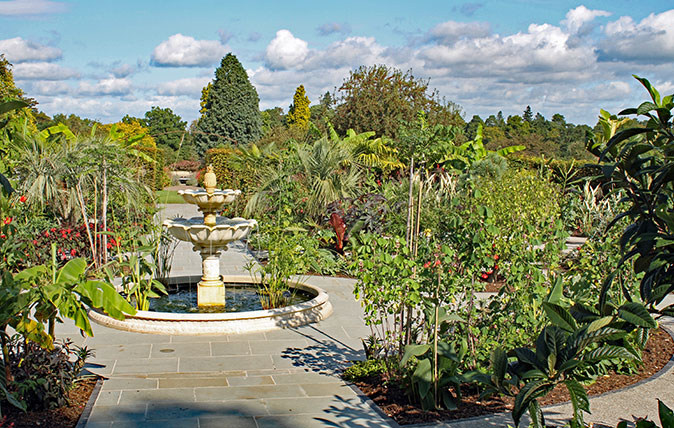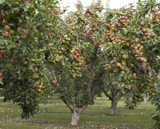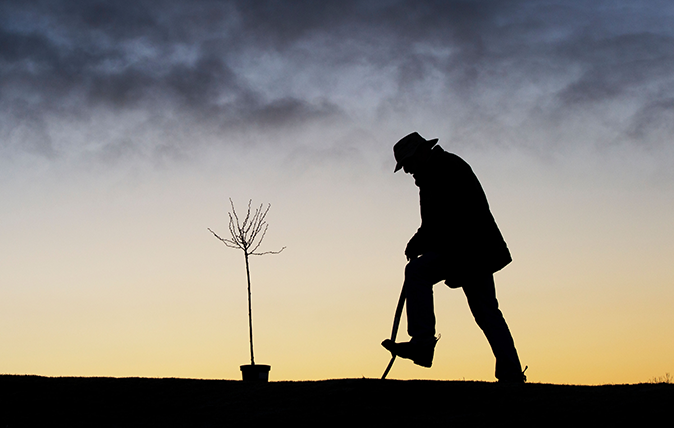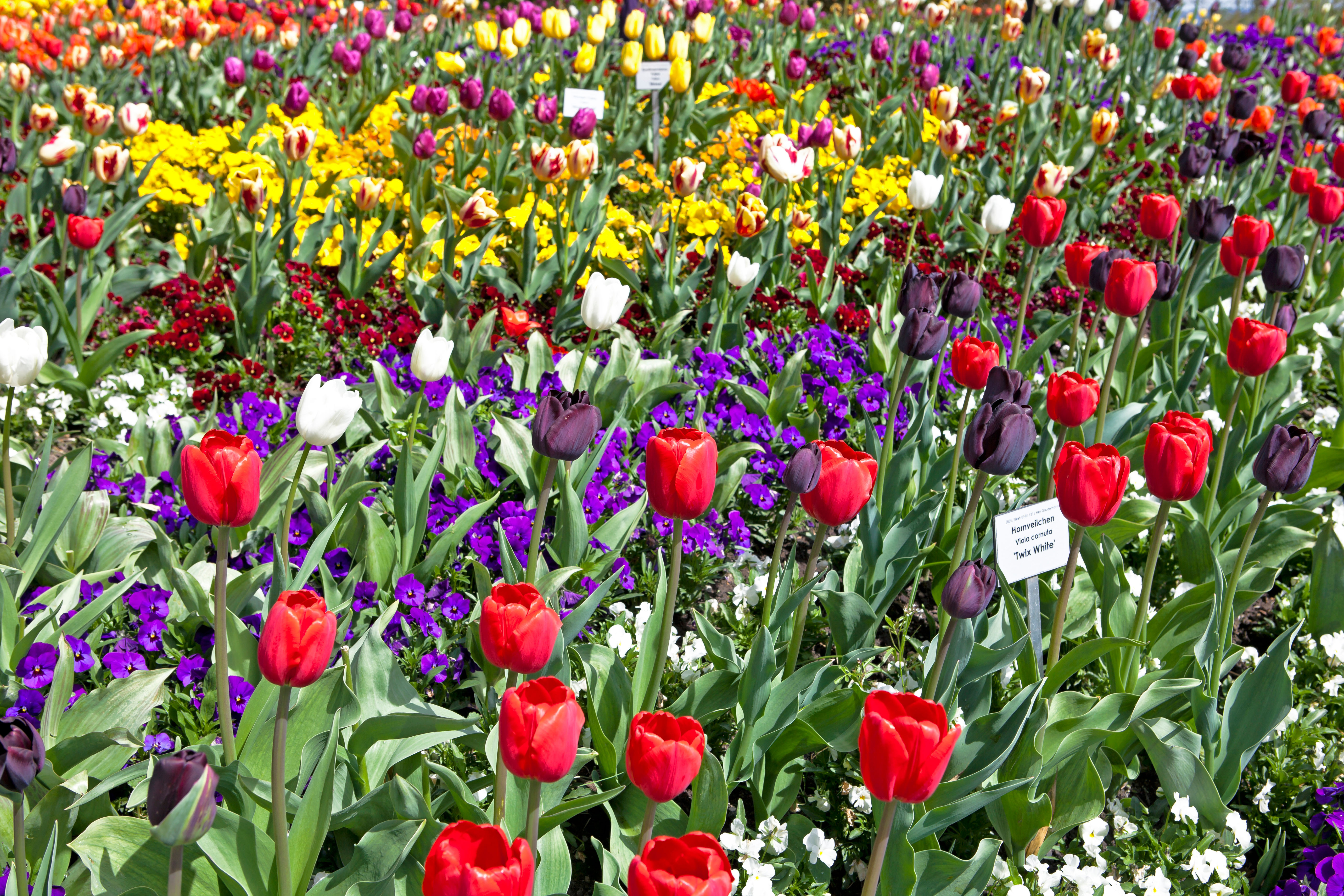Tropical fruit and palm trees in deepest Surrey? Why they’re going bananas at Wisley
A newly-planted exotic garden at RHS Wisley has torn up the rule book – it's a bold gamble for a garden in Surrey, and one which Steven Desmond traces back through centuries of adventurous English gardeners.


A nation of gardeners is bound to be eternally on the search for something more exciting in the view from the kitchen window. Every now and again, a deep-seated yearning for something with a bit more get up and go breaks through the polite surface. Away, then, with the drizzle-flecked windowpanes looking out onto familiar favourites and in with a vision of desert-island scenery.
Something of this nature has just occurred in the heathland of Surrey, in the august setting of RHS Wisley, not hitherto noted for revolutionary sentiments. Until recently, a handsome and instructive rose garden stood on the spot where we now find ourselves peering from beneath the giant paddle-shaped leaves of banana plants across a planting scheme more usually seen on the French Riviera. The exotic garden has landed.
There are limits to this extravagance, of course. Wisley is still Wisley and the new garden is framed by the hydrangeas of Battleston Hill on one side and the famous long herbaceous borders on another. The layout is also reassuringly conventional, with radiating paths circling a central fountain whose pineapple finial is fittingly modest in scale.
However, it’s the planting that catches the eye. It seems more suited to the coast of northern Queensland than the Home Counties.
'It flares up now and again only to peter out gradually as fashion moves on. Like a firework display, we should all rush now to marvel at the spectacle while it lasts'
Like all new gardens, this is a work in progress and adjustments will be made as time goes on. All the plants have been included for their dramatic form and outline and some will flourish irrespective of the character of the coming winter. These include a young monkey-puzzle tree, always so distinctive with its regularly spaced branches curving down to the ground, the whole tree covered in that perfect spiny green armour.
Other plants, such as the dahlias and cannas, are old friends. Some will remain in the ground, perhaps covered with a pot filled with straw, to re-emerge next May. The biggest of them all, Dahlia imperialis, is here, towering above my head, and everyone will want to see how it copes in this situation.
This might be a home, too, for my own favourite, D. merckii, whose shiny mauve blooms flourish outdoors in the botanic garden at Logan on the Mull of Galloway. The free drainage here will be a considerable help.
Exquisite houses, the beauty of Nature, and how to get the most from your life, straight to your inbox.
The questions, however, hang over the glasshouse favourites, including the big shrub Eriobotrya japonica. Can the loquat really survive the winter in England? Will it have to suffer the indignity of being wrapped up for months?
In fact, this new venture, a daring experiment in the expert hands of garden manager Emma Allen, is the latest in a long line of such breakouts. The stalwarts of England spluttered when Christopher Lloyd, chuckling with glee, dug up his rosebeds at Great Dixter and replaced them with planting very much along these lines.
The tradition can be traced back intermittently at least to the late 19th century, when William Robinson’s The English Flower Garden included a passage by John Gibson describing his grove of palm trees underplanted by Swiss-cheese plants in Battersea Park, in 1873.
The Jardin des Plantes in Paris beds out each year an elaborate scheme of rubber plants, bananas, bird’s-nest ferns and cannas on a lawn in, interestingly, the Jardin Anglais. And the Chusan palm, brought to these shores in the 1840s by Robert Fortune from the coast of China, has long been known as the Torquay palm.
The revolution, then, has been rumbling on for some time. Like all such things, it flares up now and again only to peter out gradually as fashion moves on. Like a firework display, we should all rush now to marvel at the spectacle while it lasts.

Help yourself to apples at RHS Wisley
A bumper harvest of apples has led RHS Wisely to invite members and guests to bring a bag and take

Credit: Alamy
Three gardening myths debunked by the ultimate guide: experience
Three gardening myths debunked by the greatest authority of all: Experience

Credit: Alamy Stock Photo
Alan Titchmarsh on bulbs: Why they're my 'firework' plants – sit back and watch them go
Alan Titchmarsh talks about his love of bulbs, which ones not to bother with, and the difference between a gardener
Country Life is unlike any other magazine: the only glossy weekly on the newsstand and the only magazine that has been guest-edited by His Majesty The King not once, but twice. It is a celebration of modern rural life and all its diverse joys and pleasures — that was first published in Queen Victoria's Diamond Jubilee year. Our eclectic mixture of witty and informative content — from the most up-to-date property news and commentary and a coveted glimpse inside some of the UK's best houses and gardens, to gardening, the arts and interior design, written by experts in their field — still cannot be found in print or online, anywhere else.
